Almost any discussion of how and when we feed our babies sets off a national debate. So to mark World Breastfeeding Week 2014 (yes, that exists), here’s a look at 16 nursing controversies, from the fracas over an Angelina Jolie breastfeeding statue to the suckling husbands phenomenon, and of course, TIME’s 2012 cover about mothers who nurse their kids into late toddlerhood:
What Starbucks Tells Employees About Breastfeeding Customers
In a sign of how supercharged the emotions have become about public nursing, a Canadian midwife’s tale of nursing her baby at a local Starbucks in Ottawa went a little viral in early July 2014, getting picked up by news outlets around the globe. The story was, to many, a heartwarming one: after a woman complained to a young, male barista that another woman was breastfeeding without a modesty shield, the barista said he’d take care of it. However, instead of telling the nursing mom to cover up, he just brought her an extra coffee for having to deal with the unpleasantness.
This is not actually Starbucks’ official policy. In fact, Starbucks doesn’t have an official policy on breastfeeding, according to spokeswoman Laurel Harper. The cappu-chain does have an official policy about making customers feel welcome, Harper noted (several times). “We empower our local partners to reach a decision about how best to make a customer’s experience a positive one,” she says. It was up to the employee to decide which customer in this case was going to have a less-positive experience.
–Belinda Luscombe
Why All the Controversy About a Black Woman Breastfeeding?
When Karlesha Thurman posted a photo of herself breastfeeding during her college graduation ceremony in June 2014, she never expected to stir up a national controversy about breastfeeding and race. She was met with a flurry of negative comments about her decision to nurse her daughter in public.
“I honestly thought that as a society, people were more understanding of breast-feeding,” Thurman, 25, told the Today Show. “It’s not disgusting, it’s not a bad thing, it’s not a negative thing.”
The photo put a spotlight on the African American community’s complicated relationship with breastfeeding. After some of the more negative comments were tweeted, the photo was picked up by Black Women Do Breastfeed, a page devoted to celebrating black women who nurse.
—Charlotte Alter
Mexico City Breast-Feeding Campaign Draws Backlash
Mexico City’s May 2014 health campaign to encourage new mothers to nurse has left a sour taste in health advocates’ mouths due to campaign posters that feature topless celebrities.
The posters show famous women without shirts or bras on, with a banner reading, “No les des la espalda, dale pecho,”or “Don’t turn you back on them, give them your breast,” strategically placed across their chests. Health advocates are peeved that the campaign both sexualizes women and faults those who choose not to breast-feed, rather than simply emphasizing the benefits of doing so.
—Eliana Dockterman
‘My Husband Wants to Breastfeed:’ The Phenomenon Nobody Talks About But Everyone Googles
It’s the suckle that dare not speak its name. In worldwide Google searches, “my husband wants me to breastfeed him” is a more popular search term than “my husband wants to separate” and “my husband wants a baby”combined.
Um, what? In May 2014, Seth Stephens-Davidowitz originally reported these numbers in the New York Times, and most of that breastfeeding search traffic is coming from India. While that doesn’t necessarily mean that breastmilk is becoming a delicacy in India, it does suggest a lot of interest. And it begs the question: is this really a thing?
Absolutely, says Dr. Wendy Walsh, a relationship expert and self-described “dairy queen” who nursed each of her children until they were 3. “Every breastfeeding mother I ever knew said their husband asked to drink it,” she says adding that the father of her child also asked to nurse once in a while.
—Charlotte Alter
“If I Could, I Would”: Photographs of Breastfeeding Dads

A March 2014 ad campaign showed photos of fathers in solidarity with breastfeeding mothers. The campaign was spearheaded by Project Breastfeeding and featured shirtless men with their children a caption of, “If I Could, I Would.”
—TIME Photo
Controversial Time Breastfeeding Cover
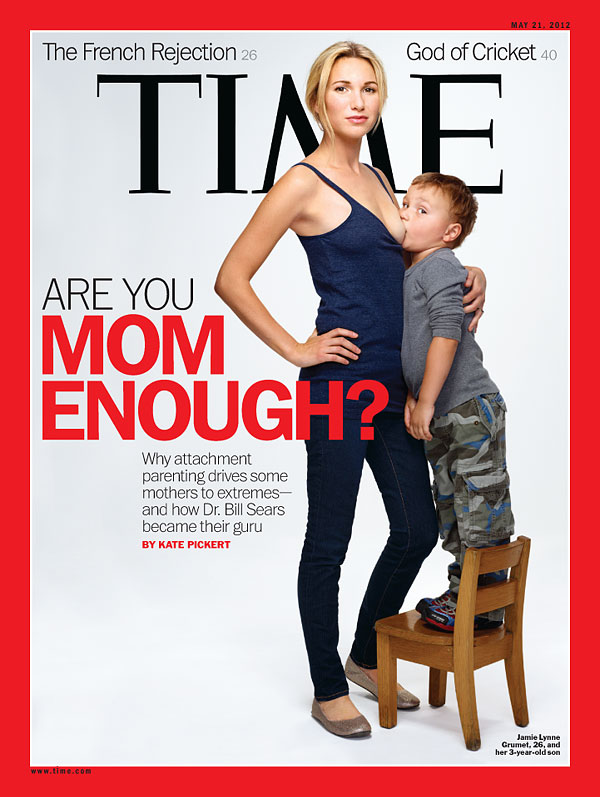
TIME stirred up its own breastfeeding controversy when the magazine featured a photo of 26-year-old Jamie Grumet breastfeeding her 3-year-old son on a May 2012 cover. Critics questioned both the decision to breastfeed a child that old and the choice to put the photo on TIME‘s cover.
In the onslaught of reaction that followed, including death threats sent to Grumet, the mother restated her support of both her breastfeeding choice and the magazine’s cover photo decision. “The statement that I wanted to make was this is a normal option for your child and it should not be stigmatized,” Grumet said. “I’m never saying this is for everybody, but it should be something that’s accepted.”
—Joan E. Greve
Sarah Palin Slams Michelle Obama
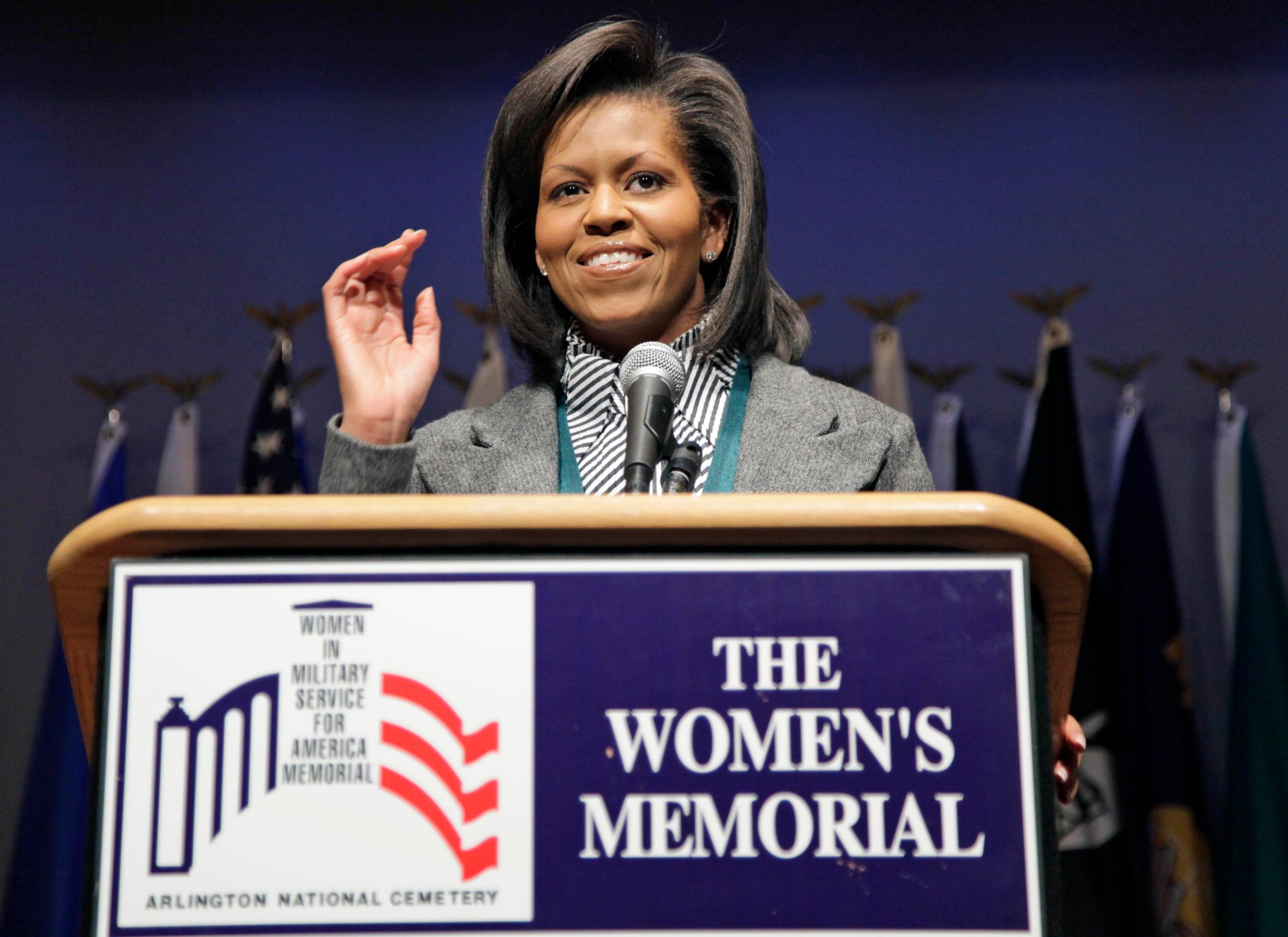
Michelle Obama probably didn’t expect her February 2011 campaign to promote breastfeeding to cause such a fuss. Then Sarah Palin weighed in: “It’s no wonder Michelle Obama is telling everybody you betterbreast-feed your baby. Yeah, you better — because the price of milk is so high right now!” After that, mom blogs on both the right and the left piled on, saying that Obama was putting too much pressure on mothers to nurse. Meanwhile, a number of newspapers dug up information showing that as governor of Alaska, Palin herself promoted breast feeding.
—Susanna Schrobsdorff
The Realistic Breastfeeding Baby Doll

The Breast Milk Baby — boringly renamed from the unfortunately titled “Bebé Glotón” (Glutton Baby) — is nothing if not good at grabbing headlines. The Spanish doll that simulates breastfeeding caught the attention of American morning shows in 2010 before it had made it across the ocean. The $69 doll made news again in 2011 after its manufacturer, Berjuan Toys, announced that the product was being released in the U.S. market.
The doll, which is sold with a brassiere-like harness for a child, suckles when pressed against strategically placed magnetic daisies positioned precisely where any real baby goes to nurse. Plenty of people, including women, have recoiled and squealed “gross!”, but why the toy nursling is so controversial goes to the roots of Americans’ squeamishness with breast-feeding in general.
—Bonnie Rochman
Julie Bowen’s Revealing Photo

The star of ABC’s smash hit Modern Family, Julie Bowen, made waves in May 2010 when she released a photo of herself topless and breast-feeding her twin sons in what’s called the “football hold” — a position that allows twins to nurse simultaneously. The image, taken from above, shows Bowen’s bare chest with the two babies latched on. When Bowen told George Lopez on TBS’ Lopez Tonight that she wasn’t allowed to show the photo on ABC’s The View, he promptly displayed it for so long that Bowen got a little embarrassed. And that was before Lopez put up Photoshopped images of the babies suctioning up various other things like the Gulf oil spill. And while Bowen may regret ever releasing the image, at least she didn’t pass judgment on women who don’t breast-feed.
—Susanna Schrobsdorff
Breastfeeding School-Age Kids
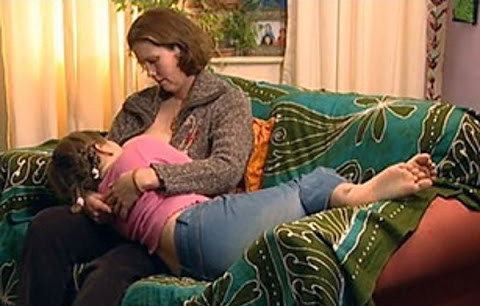
There’s lots of debate over how long to breast-feed, yet most Americans would agree that by the time a child reaches kindergarten, it’s time to stop. But not Amanda Hurst. The 29-year-old mother made headlines in 2010 by defending her decision to breastfeed both her 6-year-old and her 5-month-old. And she’s not the most extreme case. A 2006 British documentary, Extraordinary Breastfeeding, featured a mother who breast-fed her 8-year-old; viewers on YouTube have likened the practice to child abuse. And while nursing past the age of 1 is considered “extended breast feeding” in the U.S. and most Western countries, in India and parts of Africa, children are more commonly weaned later, usually between the ages of 3 and 4.
—Susanna Schrobsdorff
Facebook Accused of Censoring Breastfeeding Photos
In 2009, Facebook endured the wrath of women who noticed that photos of them breast feeding were being deleted from their profiles — even when the photos were designated as viewable by friends and family only. Facebook countered by saying that photos with nipples showing are a violation of their policies (which permit the removal of photos deemed obscene or pornographic). The company added that almost all the images they removed were flagged by other users.
The controversy hasn’t seemed to hurt Facebook much. In fact, instead of quitting the social network in protest, some of the mothers started a Facebook page to organize their cause. The“Hey Facebook, Breastfeeding Is Not Obscene” page now has more than 250,000 members and nearly 7,000 photos of babies nursing. The page has become somewhat of a hub for news about breast-feeding rights and other mothering issues.
Facebook has since updated its policy to allow for photos of mothers nursing on the social media site. “We agree that breastfeeding is natural and beautiful and we’re glad to know that it’s important for mothers to share their experiences with others on Facebook,” their policy now reads.
—Susanna Schrobsdorff
Salma Hayek Breastfeeds an African Baby
Actress Salma Hayek opened up a whole new kind of breastfeeding debate in 2009 when a video of her nursing a hungry baby boy in Sierra Leone surfaced on YouTube. Hayek told ABC’s Nightline that she fed the newborn in an effort to promote breastfeeding in a region that has one of the highest infant-mortality rates in the world, mainly due to malnutrition.
And while HIV transmission via breast feeding is a concern throughout Africa, and international health guidelines advise HIV-positive mothers to avoid breast feeding when an alternative source of nourishment is “acceptable, feasible, affordable, sustainable and safe,” those conditions aren’t often met in places like Sierra Leone where starvation is an immediate threat.
Hayek won praise for her mission, and the video prompted a wave of discussion over whether Western countries should be donating breast milk to nations in need instead of, or in addition to, infant formula.
—Susanna Schrobsdorff
A Proformula Onesie?
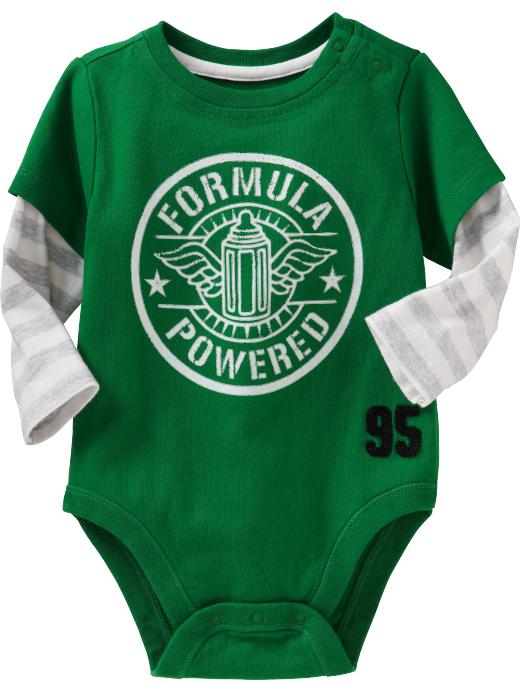
A simple $5 Old Navy T-shirt for babies set off a firestorm in 2009, thanks to what the company thought was a clever illustration of a baby bottle and the words “Formula Powered.” Breast-feeding advocates called for a boycott of the chain for encouraging baby formula over breast milk. “It was not meant to be anti–breastfeeding,” said Louise Callagy, spokeswoman of Gap Inc., Old Navy’s parent company, who also pointed out that Old Navy also manufactures nursing bras and tops. The onesie was part of a fall clothing collection with a racing theme. Cate Nelson, a blogger at the green-parenting site Eco Child’s Play wasn’t convinced. In a statement sure to inflame bottle-feeding parents, she said, “Formula simply isn’t the healthy option. So, why doesn’t Old Navy know it?”
—Susanna Schrobsdorff
The Angelina Jolie Breast-Feeding Statue
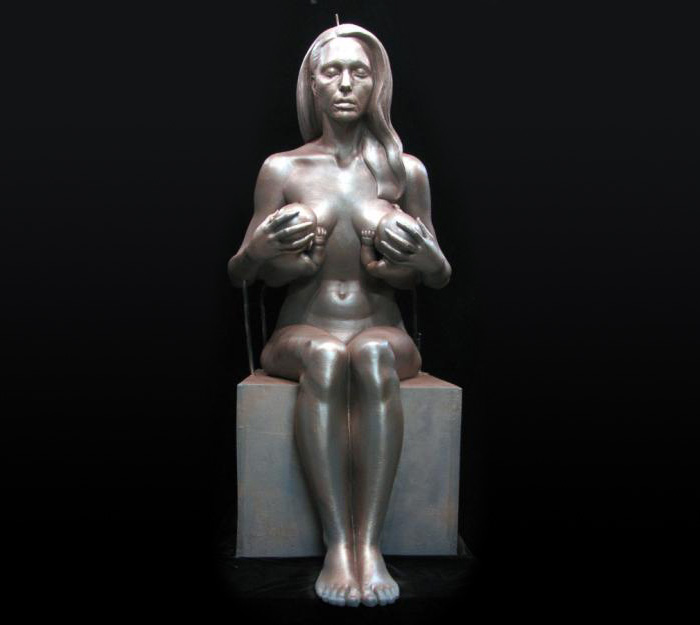
In 2009, sculptor Daniel Edwards took it upon himself to depict actress Angelina Jolie seated while feeding twin infants simultaneously for an odd-looking work entitled Landmark for Breastfeeding. The New York–based artist favors celebrity subjects, including a much publicized sculpture of Britney Spears giving birth nude, which he described as “pro-life.”
Edwards says the sculpture was originally inspired by W magazine’s 2008 cover of Jolie nursing one of her newborn twins, Vivienne and Knox. And while that image of Jolie was widely welcomed by breastfeeding advocates, it’s not entirely clear whether the grim-looking Jolie statue would inspire an increase in nursing.
—Susanna Schrobsdorff
Woman Kicked Off a Plane for Breastfeeding
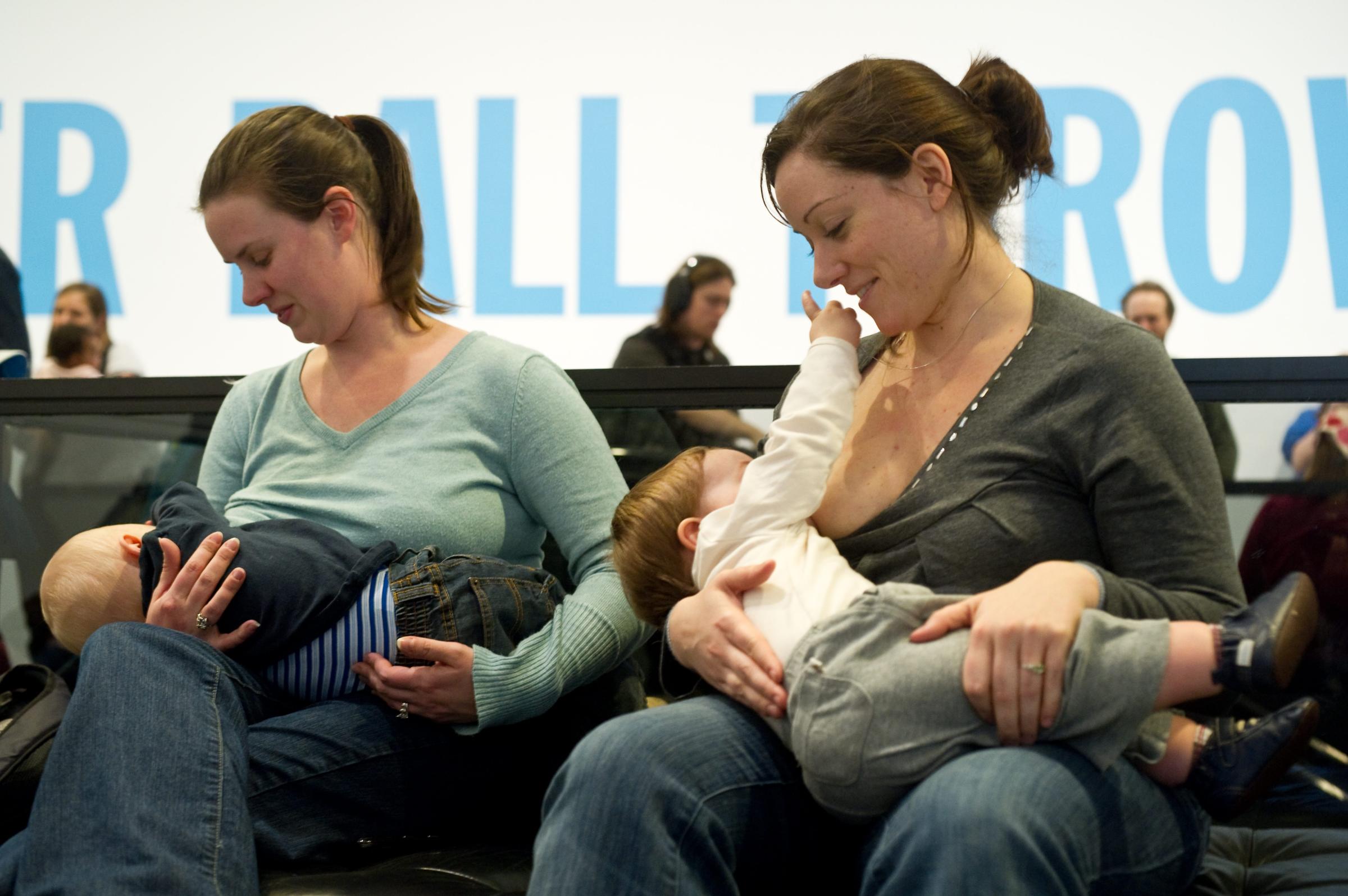
A legal dispute over public breastfeeding began in 2006 when Emily Gillette said that a Delta Connection flight attendant told her to get off the plane when she refused to cover up while nursing her 22-month-old daughter. Gillette filed a complaint with the Vermont Human Rights Commission, claiming that she was sitting discreetly by the window with her husband in the aisle seat when a flight attendant gave her a blanket. After Gillette declined the blanket, she was escorted off the plane.
The incident sparked “nurse-ins” at Delta counters across the country. And while both Delta and its partner Freedom Airlines, which operated Gillette’s flight on behalf of Delta, have apologized and reaffirmed the right of women to breastfeed on their planes, Gillette filed a civil suit against Delta in the U.S. District Court in the fall of 2009.
Gillette settled with the airlines for an undisclosed amount in March 2012.
—Susanna Schrobsdorff
Redbook’s Breastfeeding Cover

In 1997, Redbook magazine came out with what was then a fairly revolutionary cover featuring actor Pierce Brosnan gazing adoringly at his girlfriend Keely Shaye Smith as she breastfeeds their infant son. The image didn’t reveal more of Smith’s bosom than your average Oscar gown, but nonetheless, that cover only appeared on newsstands while a more traditional image of the family was on the version that went to subscribers. Editor in chief Kate White explained that the magazine produced two covers for the first time in its history because the editors didn’t want “to force the image on anyone.” Meanwhile, some convenience-store-chain owners said that if customers complained, they reserved the right to move the controversial breast-feeding cover behind the counter along with risqué men’s magazines like Playboy.
—Susanna Schrobsdorff
More Must-Reads From TIME
- The 100 Most Influential People of 2024
- The Revolution of Yulia Navalnaya
- 6 Compliments That Land Every Time
- What's the Deal With the Bitcoin Halving?
- If You're Dating Right Now , You're Brave: Column
- The AI That Could Heal a Divided Internet
- Fallout Is a Brilliant Model for the Future of Video Game Adaptations
- Want Weekly Recs on What to Watch, Read, and More? Sign Up for Worth Your Time
Contact us at letters@time.com